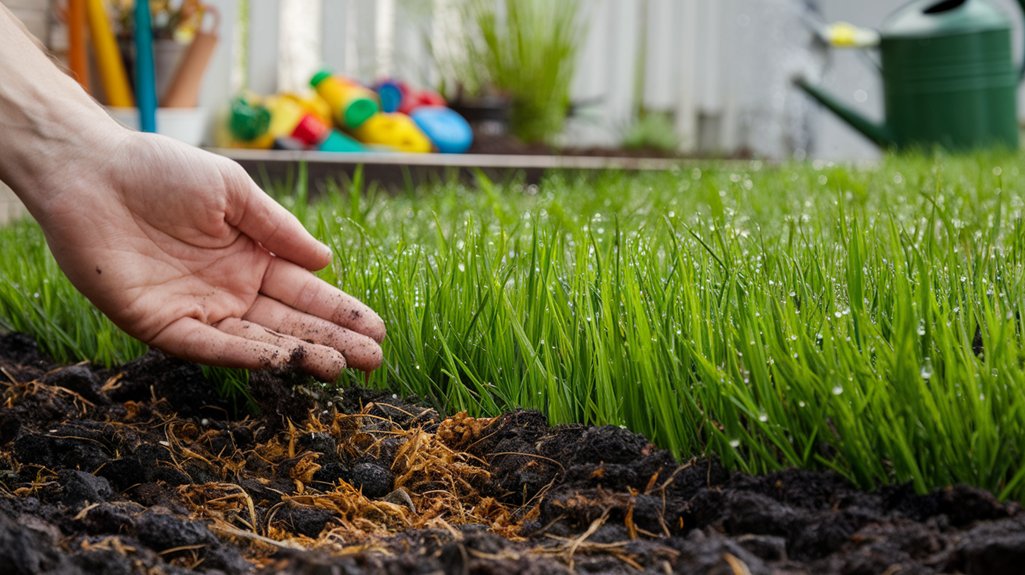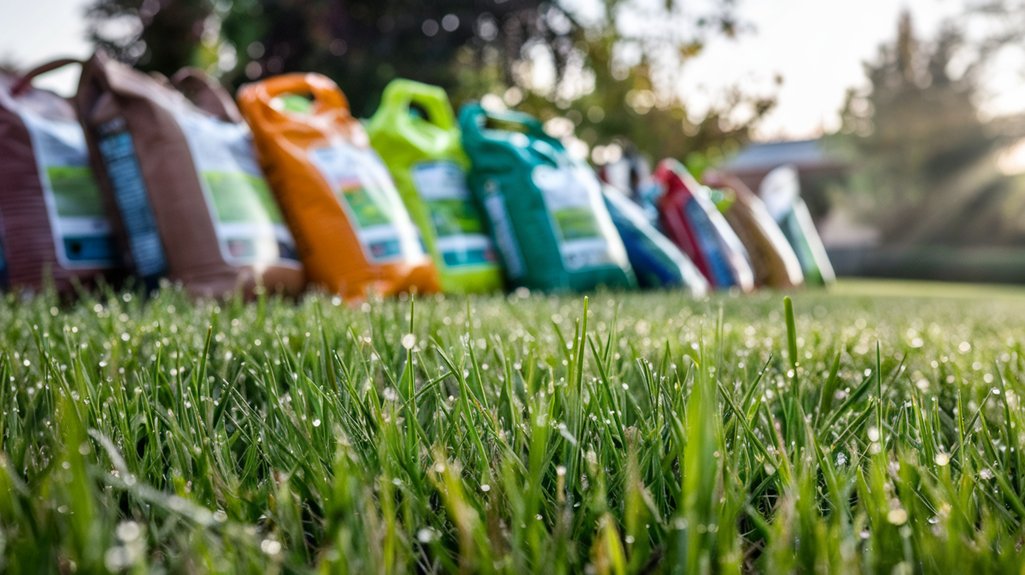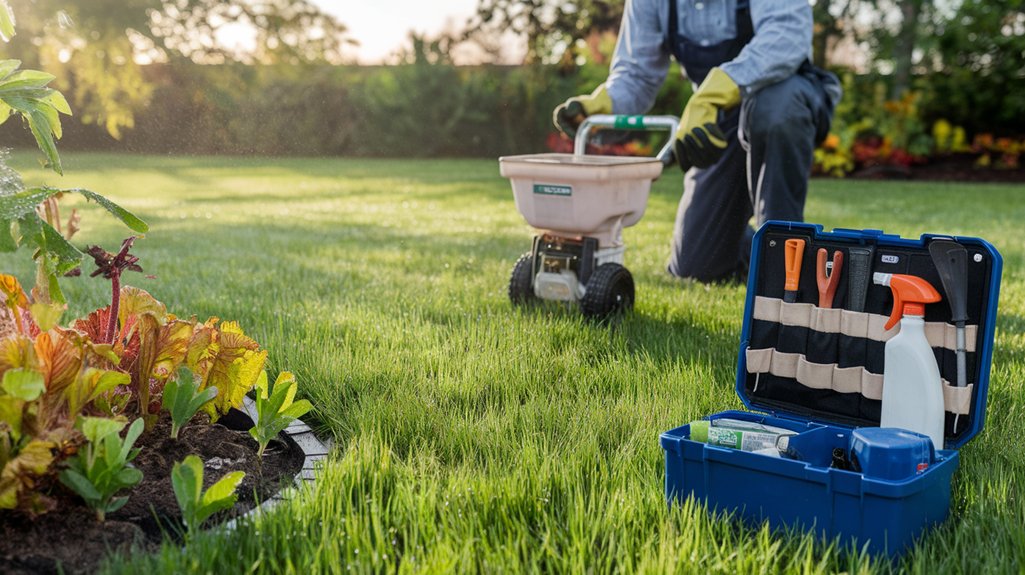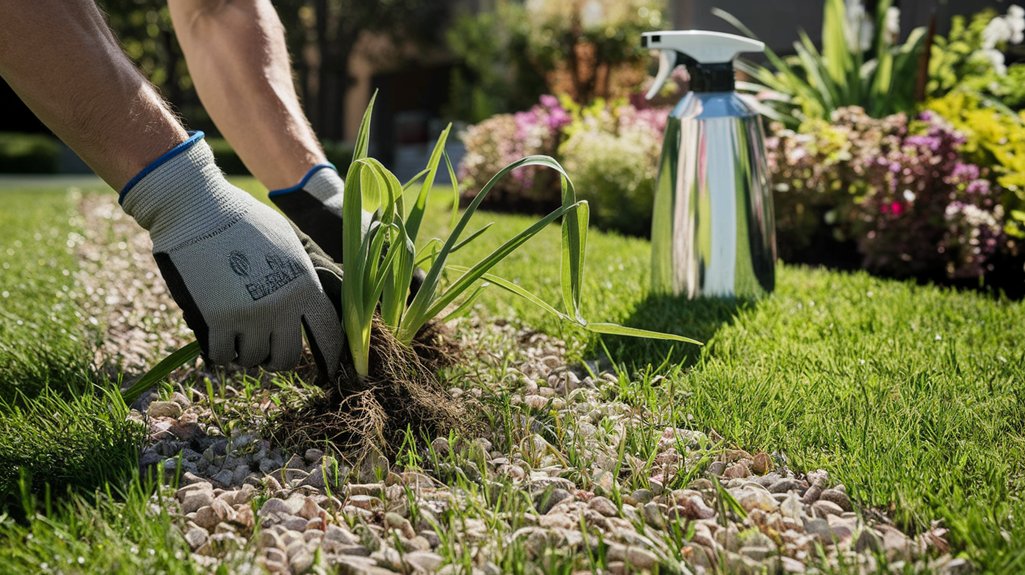When it comes to achieving a lush, healthy lawn, understanding its nutritional needs is crucial. You might find that the right fertilization strategy can significantly impact your grass’s growth. But that’s just the beginning. Effective weed control and disease prevention are equally important to maintain your lawn’s vitality. Curious about how to bring all these elements together for optimal results? Let’s explore the key strategies that will transform your lawn care routine.
Understanding Your Lawn’s Nutritional Needs

To keep your lawn healthy and vibrant, it’s essential to understand its nutritional needs. Begin with soil testing; this step reveals vital information about nutrient levels and pH balance. By knowing what your soil lacks, you’ll be able to create a nutrient balance that supports robust growth.
Pay attention to essential nutrients like nitrogen, phosphorus, and potassium, as they play crucial roles in promoting lush green grass.
Regularly assessing your soil will help you identify any deficiencies or imbalances, allowing you to make informed decisions about fertilization and amendments.
Lawn Problem Solutions ensure healthy yards. Learn lawn care from Colorado State University Extension.
Choosing the Right Fertilizer

How do you choose the right fertilizer for your lawn? Start by considering your grass type and its specific needs. Organic fertilizers are a great choice if you want to promote long-term health. They improve soil structure and provide nutrients gradually. Alternatively, slow release options give your lawn a steady supply of nutrients over time, reducing the risk of burn.
| Fertilizer Type | Benefits | Ideal For |
|---|---|---|
| Organic Fertilizers | Improves soil health | Eco-conscious owners |
| Synthetic Fertilizers | Quick nutrient boost | Fast results |
| Slow Release Options | Sustained nutrient delivery | Busy homeowners |
Effective Weed Control Strategies

Choosing the right fertilizer sets a strong foundation for a healthy lawn, but effective weed control is equally important to maintain its beauty.
Start with pre emergent herbicides, which you apply early in the season to prevent weed seeds from germinating. Timing is crucial, so follow product instructions closely.
Once weeds appear, you’ll need post emergent treatments to tackle them directly. These targeted solutions work best when applied to actively growing weeds. Remember to read labels carefully, as some products may harm your grass.
Additionally, consider cultural practices like mowing high and watering deeply to promote dense grass growth, which naturally suppresses weeds.
Common Lawn Diseases and Their Prevention
While a lush lawn is a joy to behold, it can fall prey to various diseases that threaten its health and appearance.
Two common culprits are fungal infections and bacterial blight. Fungal infections often manifest as brown patches or wilting grass, while bacterial blight appears as yellowing blades with dark streaks.
To prevent these issues, ensure your lawn has proper drainage and avoid overwatering, which creates a damp environment ideal for fungi. Regularly mowing at the correct height helps improve airflow and sunlight penetration.
Additionally, maintain a balanced fertilization schedule to promote strong grass that can resist disease. By staying vigilant and taking proactive measures, you can keep your lawn healthy and vibrant.
Best Practices for Lawn Maintenance
To maintain a healthy lawn, you need to adopt a series of best practices that cater to its specific needs.
Regular lawn mowing is crucial; keep your mower blades sharp and set at the right height to promote growth and prevent stress. Aim to mow when the grass is dry to achieve a clean cut.
Additionally, don’t overlook soil aeration. This process alleviates compaction, allowing air, water, and nutrients to penetrate deeper into the soil. Aerate your lawn at least once a year, especially in high-traffic areas.
Combine these practices with proper watering and fertilization schedules, and you’ll create a thriving lawn that stands up against weeds and diseases.
Seasonal Lawn Care Tips
As the seasons change, so do the needs of your lawn, making it essential to adjust your care routine accordingly.
In spring, focus on seasonal maintenance like fertilizing and aerating to promote healthy growth.
Summer requires regular mowing and watering, taking climate considerations into account to prevent drought stress.
As autumn arrives, it’s time for overseeding and applying a winterizer fertilizer to prepare your grass for colder months.
In winter, avoid heavy foot traffic on your lawn and consider covering it with mulch to protect against harsh conditions.
Frequently Asked Questions
How Often Should I Mow My Lawn for Optimal Health?
To maintain optimal health, you should mow your lawn regularly, ideally every 5 to 7 days. This helps keep grass height manageable, promotes healthy growth, and prevents weeds from taking over your yard.
Can I Fertilize My Lawn During Drought Conditions?
Fertilizing your lawn during drought isn’t ideal; the drought impact can stress grass further. Instead, focus on proper fertilization timing when conditions improve, ensuring your lawn receives nutrients without adding more stress during dry periods.
What Tools Do I Need for Effective Lawn Care?
For effective lawn care, you’ll need essential lawn care tools like a mower, trimmer, and rake, along with maintenance equipment such as a spreader and aerator. These tools help keep your lawn healthy and vibrant.
How Do I Tell if My Lawn Is Overwatered?
To tell if your lawn’s overwatered, check for waterlogged soil. If you notice wilting grass despite moist ground, it’s a sign your lawn’s getting too much water. Adjust your watering schedule accordingly.
Is Lawn Care Different for Shaded Areas?
Yes, lawn care differs for shaded areas. Shaded grasses have specific light requirements, needing less sunlight than their sun-loving counterparts. You’ll want to adjust watering, fertilization, and mowing practices to accommodate their unique needs.
To achieve a lush, healthy lawn, remember to assess your lawn’s nutritional needs and choose the right fertilizer accordingly. Stay proactive with effective weed control strategies and keep an eye out for common diseases to prevent them before they take hold. Embrace best practices for maintenance and adapt your care routine with the seasons. By following these expert tips, you’ll enjoy a vibrant lawn that’s the envy of the neighborhood all year round.
Contact Us
Lawn Problem Solutions with Above & Beyond Services revive your Denver lawn. Call (720) 806-6378 or visit Above & Beyond Services for free quotes on lawn care, pest control, and more.
Key Takeaways
- Conduct regular soil tests to determine nutrient levels and pH balance for effective fertilization strategies.
- Choose fertilizers based on grass type, opting for organic for gradual release or synthetic for quick results.
- Implement pre-emergent herbicides to prevent weed growth and apply post-emergent treatments to address active weeds.
- Maintain proper lawn care practices, including mowing height and frequency, to reduce disease risk and enhance lawn health.
- Aerate your lawn annually to alleviate compaction, improve nutrient penetration, and promote robust grass growth.




